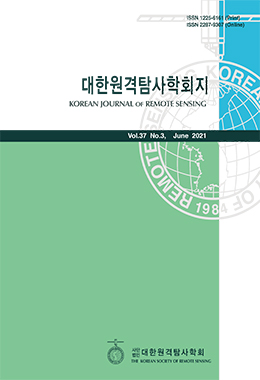에어로솔은 입자의 크기와 조성 및 관측센서에 따라 상이한 분광특성을 보이기 때문에, 다양한 센서의 에어로솔 산출물에 대한 비교분석이 반드시 필요하다. 그러나, 우리나라에서 다종위성의 공식적인 AOD (Aerosol Optical Depth) 산출물을 대상으로 수년간의 자료를 수집하여 정확도 비교평가를 수행한 사례는 아직 보고된 바가 없다. 이에, 본 연구에서는 2015년 1월부터 2019년 12월까지 MODIS (Moderate Resolution Imaging Spectroradiometer), VIIRS (Visible Infrared Imaging Radiometer Suite), Himawari-8, Sentinel-3 AOD 산출물과 AERONET (Aerosol Robotic Network) 지상 태양광도계 자료의 비교분석을 통하여 위성 AOD의 성능을 평가하고, 계절적 및 지리적 차이에 따른 정확도 특성을 분석하였다. 오랜 기간 축적되어온 산출 기술에 MAIAC (Multiangle Implementation of Atmospheric Correction) 알고리듬을 추가하여 최적화된MODIS 산출물이 가장 높은 정확도를 나타냈고(CC=0.836), VIIRS와 Himawari-8이 그보다 약간 낮은 정도의 성능을 보였으며, Sentinel-3는 비교적 최근에 발사되어 알고리듬 최적화가 아직 덜 이루어진 관계로 정확도가 낮게 나타났다. MODIS, VIIRS, Himawari-8 AOD 산출물은 계절에 따라, 그리고 도시/비도시에 따라 별다른 정확도 차이를 보이지는 않았지만, 일부 해안지역에서는 혼합화소 문제로 인하여 약간 정확도가 떨어지는 경우도 존재했다. AOD는 위성영상 대기보정의 핵심 인자이기 때문에, 본 연구의 AOD 비교평가는 향후 국토위성, 농림위성 등의 대기보정 연구에도 중요한 참고자료가 될 것으로 사료된다.
Because aerosols have different spectral characteristics according to the size and composition of the particle and to the satellite sensors, a comparative analysis of aerosol products from various satellite sensors is required. In South Korea, however, a comprehensive study for the comparison of various official satellite AOD (Aerosol Optical Depth) products for a long period is not easily found. In this paper, we aimed to assess the performance of the AOD products from MODIS (Moderate Resolution Imaging Spectroradiometer), VIIRS (Visible Infrared Imaging Radiometer Suite), Himawari-8, and Sentinel-3 by referring to the AERONET (Aerosol Robotic Network) sun photometer observations for the period between January 2015 and December 2019. Seasonal and geographical characteristics of the accuracy of satellite AOD were also analyzed. The MODIS products, which were accumulated for a long time and optimized by the new MAIAC (Multiangle Implementation of Atmospheric Correction) algorithm, showed the best accuracy (CC=0.836) and were followed by the products from VIIRS and Himawari-8. On the other hand, Sentinel-3 AOD did not appear to have a good quality because it was recently launched and not sufficiently optimized yet, according to ESA (European Space Agency). The AOD of MODIS, VIIRS, and Himawari-8 did not show a significant difference in accuracy according to season and to urban vs. non-urban regions, but the mixed pixel problem was partly found in a few coastal regions. Because AOD is an essential component for atmospheric correction, the result of this study can be a reference to the future work for the atmospheric correction for the Korean CAS (Compact Advanced Satellite) series.




